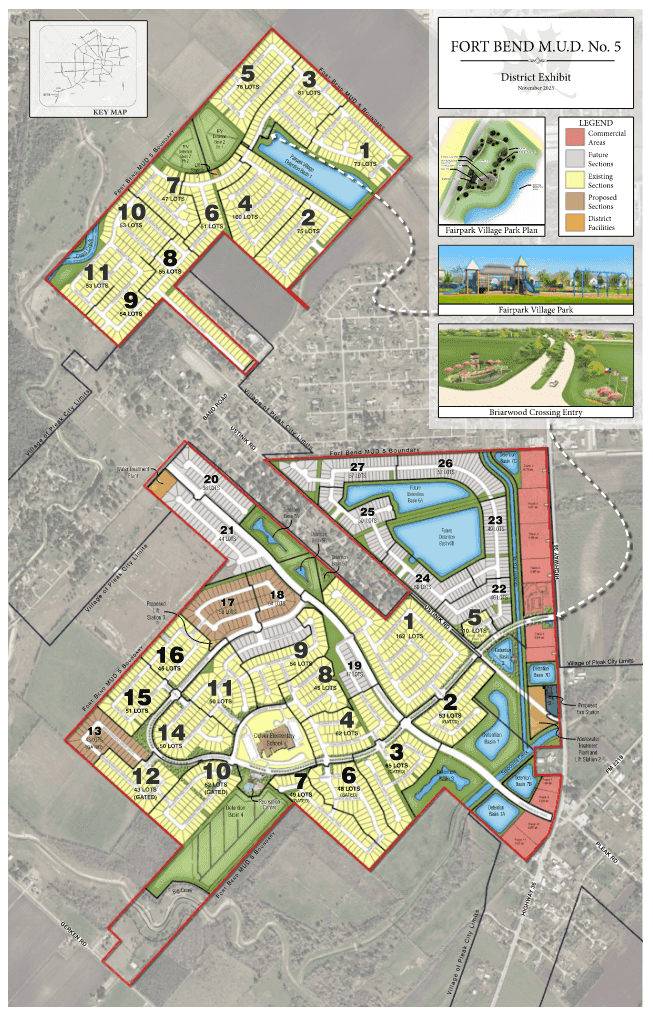As many residents may already know, the Board of Directors (the "Board") of Fort Bend County Municipal Utility District No. 5 (the "District" or “FBCMUD 5”) has called for a bond authorization proposition to be on the election ballot for Tuesday, November 4, 2025. To ensure that residents and other constituents of the District have accurate information regarding the proposed authorization, we have put together answers for common questions. This page will be updated to address additional questions and provide additional information prior to the election.
What is Fort Bend County Municipal Utility District No. 5?
Fort Bend Municipal Utility District No. 5 is a municipal utility district and political subdivision of the State of Texas. It is authorized to purchase, construct, operate, and maintain water, sanitary sewer, storm sewer, drainage, and park and recreational facilities to serve the land contained within its boundaries. The District currently contains approximately 1,500 single-family residences across 820 acres (Briarwood Crossing and Fairpark Village subdivisions). It also contains 1 gas station and 1 elementary school campus.

FBCMUD 5 currently operates and maintains 1 water plant with 1 onsite water well, 3 sanitary sewer lift stations, and 1 wastewater treatment plant. This infrastructure is connected by 16 miles of water lines, and 15 miles of sanitary sewer lines. Additionally, FBCMUD 5 has 10 detention basins.
What is the election?
The language below will be on the ballot for residents of the District when they go to the polls or vote by mail for the November 4, 2025 election, asking voters to select one (1) option of either FOR or AGAINST on the following propositions:
PROPOSITION A –
THIS IS A TAX INCREASE
THE ISSUANCE OF $38,000,000 BONDS FOR WATER, SANITARY SEWER, AND DRAINAGE AND STORM SEWER SYSTEMS AND FOR REFUNDING WATER, SANITARY SEWER, AND DRAINAGE AND STORM SEWER SYSTEMS BONDS OF THE DISTRICT, AND THE LEVY OF TAXES, WITHOUT LIMIT AS TO RATE OR AMOUNT, SUFFICIENT TO PAY THE PRINCIPAL OF AND INTEREST ON THE BONDSPROPOSITION B-
THIS IS A TAX INCREASE
THE ISSUANCE OF $20,000,000 BONDS FOR RECREATIONAL FACILITIES AND FOR REFUNDING RECREATIONAL FACILITIES BONDS OF THE DISTRICT, AND THE LEVY OF TAXES, WITHOUT LIMIT AS TO RATE OR AMOUNT, SUFFICIENT TO PAY THE PRINCIPAL OF AND INTEREST ON THE BONDS
These propositions are related to the bond authorization amounts the District is seeking to complete water, sanitary sewer, storm sewer, and drainage infrastructure (Proposition A) and park and recreational facilities (Proposition B).
What is a bond authorization?
A bond authorization is an authorization to sell bonds to fund district projects. It is similar to a line of credit that a business might use to fund its operations. An authorization is not immediate funding, nor is it a “blank check” to fund the entire amount of the authorization without meeting strict regulatory requirements. While an authorization may be for a large amount, bonds may only be sold once necessary projects are ready to begin or as needed for repairs and maintenance or replacement, and so that certain state-mandated economic requirements are satisfied.
As of the November 4, 2025, election, the District is expected to have $16,260,000 in remaining bonding authority for water, sanitary sewer, storm sewer, and drainage infrastructure and $0.00 in bonding authority for park and recreational facilities. The most recent bond authorization was in 2006, and the amount of bonds authorized by the District's voters in the 2006 election totaled $87,000,000.00 for the purpose of water, sanitary sewer, storm sewer, and drainage facilities. The authorized bond amounts have been issued periodically, as needed, to fund necessary projects for the water, sanitary sewer and drainage infrastructure in the District.
What will the WS&D bond authorization be used for?
The Bond Election Report submitted by the District engineer identifies the projects the Board anticipates will be necessary over the next 10 years to expand, maintain, replace, or upgrade the aging water, sanitary sewer, and drainage infrastructure owned and operated by the District, as well as roads, parks and recreational facilities. As a proactive measure, the Bond Election Report outlines the potential cost for those projects (and required bond issuance costs), considering all information available today.
Since the inception of the District, an interim wastewater treatment plant has been in use with the intention of eventually constructing a permanent facility. The need for a permanent wastewater treatment plant has become more pressing over time. Due to inflation and evolving agency regulations, both the necessity and cost of this project have increased significantly. Additionally, changes in detention requirements following Hurricane Harvey have increased the costs of detention and drainage facilities.
What is the Park’s bond authorization be used for?
The park bond authorization can only be used for the acquisition, design, and construction of recreational facilities, which generally can include forests, greenbelts, open spaces, and native habitats; certain sidewalks, trails, paths, boardwalks, and fitness trail equipment; certain pedestrian bridges and underpasses; outdoor ball fields, parks, amenity lakes and associated water features (subject to certain restrictions); certain amenity/recreational centers, outdoor tennis courts, and outdoor basketball courts; landscaping and parking related to the above items; and certain fencing.
Why is it necessary to do these projects?
The District was created in 1974 and initially contained 207.188 acres. Between 2006-2017 the district has continued to annex land into its boundaries, and now contains approximately 820 acres. As the District has grown, the infrastructure has been expanded to meet the needs of the residents. Also, as such infrastructure ages, it requires maintenance, rehabilitation, and, sometimes, replacement as part of its lifecycle. On average, infrastructure lasts about 30-40 years with optimal maintenance and operations.
The District intends to issue bonds only as necessary over the next 10 years pursuant to the Bond Election Report in order to proactively maintain, and, if necessary, implement repairs or replacement to its facilities. This will enable the District to purchase, construct, acquire, own, maintain, operate, repair, improve, extend, and pay for the water, sanitary sewer, storm sewer, and drainage facilities as well as roads, and parks and recreational facilities to serve the District.
Can’t the District just pay for projects without issuing bonds?
The primary alternative to authorizing the bonds is to fund all necessary projects on a "pay as you go" basis. This could result in increases in the District’s maintenance tax rates and/or water and sanitary sewer rates in order to collect the required funds. Further, the law requires the District to have the necessary funds in hand before it can proceed with a qualified project. If the District is forced to raise the necessary money on an as-you-go basis, it could create significant delays in the completion of large projects. Much like a home equity loan for a major roof repair, when the District issues bonds, it spreads the costs of the necessary projects over several years with the goal of avoiding increases to the tax rate and/or water and sanitary sewer rates typically required by a "pay as you go" approach. Moreover, the interest rates for the District on the re-payments of its municipal bonds can be lower than the comparable rates for traditional construction loans; tax-exempt bonds are an efficient use of funding for District projects. Financing infrastructure through the issuance of bonds enables the District to complete projects timely quickly should the need arise.
How are my taxes determined?
The District levies a total tax rate each year that has two components:
- The debt service tax rate, the proceeds of which can only be used to make payments on the District’s outstanding bonds; and
- The operations and maintenance tax rate (often referred to as O&M), the proceeds of which are deposited to the District’s General Fund and used, together with water and sewer revenue, to pay operating and maintenance expenses of the District.
These two components of the tax rate have changed over the years as the District’s debt service and operating expenses have changed.
How does the District manage taxpayer dollars?
The Board has been able to lower the District's total tax rate since 2020 at a rate from $1.41/ $100 to $1.25/ $100. For more details regarding tax rates, click here. As a result of prudent financial management, the District has earned an “Baa2” rating from Moody’s Financial Services LLC.
The District currently has approximately 14 months of operating reserve funding. A common benchmark for municipal utility districts is generally 12 months. Reserve funds earn interest and are available for emergencies, but can prove to be insufficient if large-scale rehabilitation, repair, or replacement is required, as in the case of plant facility failure or compromise.
The goal of the Board of Directors is to manage the maintenance tax rate effectively to offset increases in the debt service tax rate and to limit overall increases in the ad valorem tax rate as approved bonds are sold to fund future necessary projects.
I have more questions…
Good! The goal is for the residents to have all the information at their disposal when voting approaches. Additional questions can be fielded through the Contact Us form on the District’s website.
